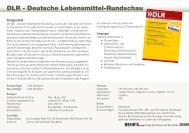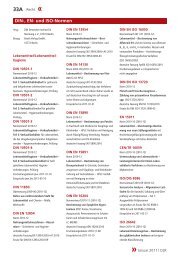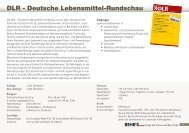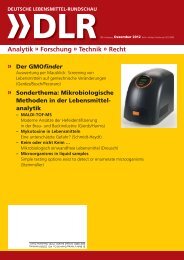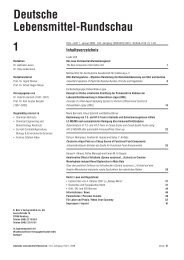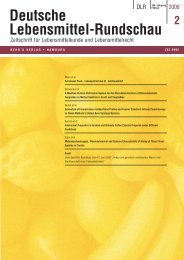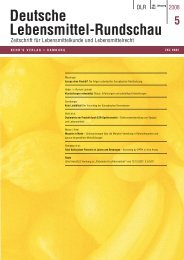Nanotechnologie in Lebensmitteln - DLR Online: Deutsche ...
Nanotechnologie in Lebensmitteln - DLR Online: Deutsche ...
Nanotechnologie in Lebensmitteln - DLR Online: Deutsche ...
Sie wollen auch ein ePaper? Erhöhen Sie die Reichweite Ihrer Titel.
YUMPU macht aus Druck-PDFs automatisch weboptimierte ePaper, die Google liebt.
48<br />
Orig<strong>in</strong>alarbeiten «<br />
multaneous determ<strong>in</strong>ation of Zn, Cu, Pb and Cd <strong>in</strong> w<strong>in</strong>e<br />
samples, (ii) flame atomic absorption spectrometry (FAAS)<br />
for <strong>in</strong>dividual determ<strong>in</strong>ation of Zn and Cu content, and<br />
(iii) Zeeman graphite furnace atomic absorption spectrometry<br />
(ZGFAAS) for <strong>in</strong>dividual determ<strong>in</strong>ation of Pb and Cd<br />
content. ZGFAAS method was selected for determ<strong>in</strong>ation<br />
of Pb and Cd due to its sensitivity, accurate background<br />
correction (Zeeman-effect background correction), and because<br />
this method provides detection limit low enough to<br />
measure the usually low content of Pb and Cd <strong>in</strong> w<strong>in</strong>es.<br />
Simultaneous determ<strong>in</strong>ation of Zn, Cu, Pb and Cd content<br />
<strong>in</strong> w<strong>in</strong>es were carried out by flow-through stripp<strong>in</strong>g chronopotentiometry<br />
(FTSCP) method. FTSCP is a two-step<br />
analytical method. In the first step, the analyte species are<br />
collected at a work<strong>in</strong>g electrode, which is set to a suitable<br />
deposition potential or at a suitable deposition current. After<br />
a short quiescence period, <strong>in</strong> the second step the deposit<br />
was stripped by a constant current, whereas the change of<br />
the potential of the work<strong>in</strong>g electrode dur<strong>in</strong>g the dissolution<br />
is registered. The potential-time dependence gives the<br />
duration of the dissolution (chronopotentiometric stripp<strong>in</strong>g<br />
time) which is accord<strong>in</strong>g to the Faraday’s lows of electrolysis<br />
proportional to the analyte concentration. The<br />
orig<strong>in</strong>al S-shape of potential-time dependence is converted<br />
(transformed) to a peak-like signal conta<strong>in</strong><strong>in</strong>g the stripp<strong>in</strong>g<br />
peaks of the deposited species. The compact flow system<br />
operates fully automatic; it conta<strong>in</strong>s computer controlled<br />
electromagnetic valves for switch<strong>in</strong>g either the carrier electrolyte,<br />
sample or standard solutions to the flow. The electrolyte,<br />
solutions or samples are driven through the system<br />
and cell by a peristaltic pump. The hearth of the system is<br />
the compact flow-through electrochemical cell with porous<br />
flow-through work<strong>in</strong>g electrode.<br />
Electrochemical FTSCP measurements were performed on<br />
a fully automated computer controlled electrochemical analyser<br />
EcaFlow Model 150 GLP (Istran Ltd., Bratislava,<br />
Slovakia) equipment with two solenoid <strong>in</strong>ert valves, a peristaltic<br />
pump, 1 mm <strong>in</strong>ner diameter PTFE tub<strong>in</strong>g and microprocessor<br />
controlled potentiostat/galvanostat. The compact<br />
three-electrode flow-through electrochemical cell of<br />
type 104 (Istran Ltd., Bratislava, Slovakia), equipment<br />
with Pt auxiliary, Ag/AgCl reference and vitreous carbon<br />
macro porous work<strong>in</strong>g electrode (E104L, Istran Ltd.) was<br />
used.<br />
The determ<strong>in</strong>ation of Zn and Cu by FAAS was carried out<br />
on Perk<strong>in</strong>-Elmer (PE) Model 1100 spectrophotometer, and<br />
the experimental equipment used for Pb and Cd determ<strong>in</strong>ation<br />
by ZGFAAS was Zeeman atomic absorption spectrophotometer,<br />
Perk<strong>in</strong>-Elmer (PE) Model 4100ZL with<br />
Zeeman graphite furnace, pyrolytic graphite tubes (HGA)<br />
with L’vov platforms and autosampler PE Model AS-71.<br />
Instrumental conditions<br />
Operation parameters for FTSCP were as follows: The<br />
deposition of metal ions from w<strong>in</strong>e samples on carbon porous<br />
work<strong>in</strong>g electrode is performed by apply<strong>in</strong>g a suitable<br />
deposition potential, i.e. <strong>in</strong> the potentiostatic mode at –<br />
1800 mV. The deposit was stripped galvanostatically by<br />
apply<strong>in</strong>g a stripp<strong>in</strong>g current of 200 μA, whereas stripp<strong>in</strong>g<br />
chronopotentiogram is recorded and evaluated. Others parameters<br />
were: start<strong>in</strong>g potential I, –1800 mV; start<strong>in</strong>g potential<br />
II, –1400 mV; end potential, 100 mV; quiescence<br />
time I 5 s; quiescence time II 30 s; sample volume, 1 ml;<br />
flow rate, 6 ml/m<strong>in</strong>.<br />
The <strong>in</strong>strumental conditions for ZGFAAS measurements<br />
were: resonance wavelength, 283.3 nm for Pb, and<br />
228.8 nm for determ<strong>in</strong>ation of Cd; slit with, 0.7 nm; signal<br />
process<strong>in</strong>g parameter, peak-area mode; <strong>in</strong>jection volume,<br />
20 μl. The temperature and gas programmes were as follows:<br />
For determ<strong>in</strong>ation of Pb: step 1: temperature 110 °C,<br />
1 s ramp time, 50 s hold time, argon flow 250 ml/m<strong>in</strong>; step<br />
2 temperature 500 °C, 5 s ramp time, 30 s hold time, argon<br />
flow 250 ml/m<strong>in</strong>; step 3: temperature 1900 °C, 0 s ramp<br />
time, 5 s hold time, argon flow stop; step 4: temperature<br />
2400 °C, 1 s ramp time, 2 s hold time, argon flow 250 ml/<br />
m<strong>in</strong>. For determ<strong>in</strong>ation of Cd the conditions were: step 1:<br />
temperature 110 °C, 1 s ramp time, 50 s hold time, argon<br />
flow 250 ml/m<strong>in</strong>; step 2: temperature 400 °C, 30 s ramp<br />
time, 30 s hold time, argon flow 250 ml/m<strong>in</strong>; step 3: temperature<br />
700 °C, 10 s ramp time, 20 s hold time, argon flow<br />
250 ml/m<strong>in</strong>; step 4: temperature 1400 °C, 0 s ramp time, 5 s<br />
hold time, argon flow stop; step 5: temperature 2400 °C, 1 s<br />
ramp time, 2 s hold time, argon flow 250 ml/m<strong>in</strong>.<br />
The <strong>in</strong>strumental conditions for flame atomic absorption<br />
spectrometry (FAAS) were: resonance wavelength,<br />
324.7 nm for Cu and 213.8 nm for Zn; slit width, 0.7 nm;<br />
signal process<strong>in</strong>g parameter, peak-area mode; flame type,<br />
air/acetylene flame.<br />
Reagents<br />
Analytical-reagent grade chemicals were used <strong>in</strong> all experiments.<br />
Al electrolyte and solutions were prepared with ultrapure<br />
(double-distilled deionised) water obta<strong>in</strong>ed from a<br />
Millipore Milli-Q purification system (specific resistance of<br />
ultrapure water was greater or equal to 18 MΩ cm).<br />
The carrier electrolyte for FTSCP measurements was solution<br />
0.01 mol dm -3 CH 3 COOH + 0.01 mol dm -3<br />
CH 3 COONa + 0.2 mol dm -3 NaCl. The electrolyte for<br />
preparation (dilution) of w<strong>in</strong>e samples and preparation of<br />
standard solutions of heavy metals was solution 0.1 mol<br />
dm -3 HCl. The standard solution of heavy metals for additions<br />
to the w<strong>in</strong>e sample, concentration of: 400 μg/l Zn;<br />
10 μg/l Cd; 20 μg/l Pb and 40 μg/l Cu, was prepared from<br />
certified reference materials (Istran Ltd.) by simple dilut<strong>in</strong>g<br />
with 0.1 mol dm -3 HCl.<br />
For the ZGFAAS and FAAS measurements a stock solutions<br />
of 1000 mg/l of Pb, Cd, Cu and Zn, (Merck) were<br />
used as the reference standard. Work<strong>in</strong>g standards of different<br />
concentration range (depend<strong>in</strong>g on the element and<br />
the method of determ<strong>in</strong>ation) were prepared from the stock<br />
(reference) standard by dilution with 0.15 % nitric acid solution<br />
(Suprapur, Merck).<br />
» November/Dezember 2008 | <strong>DLR</strong>




